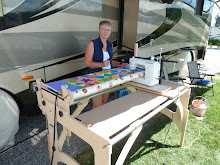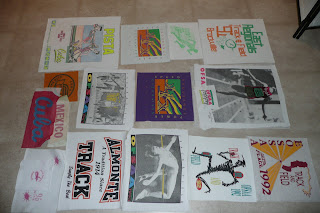On Tuesday a friend met me at my fibre art exhibit and later we had lunch and browsed through some of the local shops. I don't think either of us started out with the intent of making purchases but some of the shops had buys that were just too hard to pass up. Among my purchases was a pair of slacks, regular price $70 for $20. At 5'9" I often have difficulty getting pants that are long enough but this pair met that criteria. I also often have trouble getting sufficient crotch depth. This pair had depth to spare but did not sit right around the waist. I looked at them for a few moments and this is what my mind saw - not what they looked like in the store -good length, level waistline, few puckers - and this is also what they looked like after a few alterations! The pants are a stretchy rayon polyester blend with a wonderfully soft yet stretchy feel but unless fitted properly presented a bit of a challenge for my 'round' tummy!
 While trying on the slacks, I determined that the 'no waistband' with elastic insert waistline would be easy to 'unsew' so that was the first step in my work today. Note that the waistline is almost correct in the centre front but an inch and a half high at the side seams. I had anticipated that this was part of the problem. Last fall, while drafting a updated pant pattern, I found it hard to believe how much a standard pattern needed to be altered at the waistline to provide the smooth fit required. In spite of weight gain over the years, three babies and years of computer work, resulting in little muscle tone where it counts, I have retained significant waist definition !
While trying on the slacks, I determined that the 'no waistband' with elastic insert waistline would be easy to 'unsew' so that was the first step in my work today. Note that the waistline is almost correct in the centre front but an inch and a half high at the side seams. I had anticipated that this was part of the problem. Last fall, while drafting a updated pant pattern, I found it hard to believe how much a standard pattern needed to be altered at the waistline to provide the smooth fit required. In spite of weight gain over the years, three babies and years of computer work, resulting in little muscle tone where it counts, I have retained significant waist definition !
 I used some soft cord to mark where my waistline should fall. To determine this I worked with the side seams to remove the wrinkles from the crotch and inner leg. The cord actually was sitting level, but one of the joys of trying to photograph techniques by oneself is making do - I extended my arms to take the picture and the cord distorted!
I used some soft cord to mark where my waistline should fall. To determine this I worked with the side seams to remove the wrinkles from the crotch and inner leg. The cord actually was sitting level, but one of the joys of trying to photograph techniques by oneself is making do - I extended my arms to take the picture and the cord distorted!
 Because I also tapered the front crotch seam, which is normally a straight seam, to provide some front 'roundness', the elastic was long enough for the new waistline and did not need to be replaced or extended. I pinned it in place with one edge along the marked new waistline (I used pins on the right side rather than pencil or chalk). I used a stretch overcast stitch on my sewing machine to rejoin the elastic and pant fabric along the bottom edge - not the top - of the elastic. You can see how much excess fabric resulted! Trying the pants on once more to confirm the fit, I then trimmed the fabric close to the stitching. I may use some fraychek but on the other hand, with the stitch used, it shouldn't be necessary.
Because I also tapered the front crotch seam, which is normally a straight seam, to provide some front 'roundness', the elastic was long enough for the new waistline and did not need to be replaced or extended. I pinned it in place with one edge along the marked new waistline (I used pins on the right side rather than pencil or chalk). I used a stretch overcast stitch on my sewing machine to rejoin the elastic and pant fabric along the bottom edge - not the top - of the elastic. You can see how much excess fabric resulted! Trying the pants on once more to confirm the fit, I then trimmed the fabric close to the stitching. I may use some fraychek but on the other hand, with the stitch used, it shouldn't be necessary.
 One of the advantages of doing alterations to ready made clothes is learning some of the techniques used. In this case I realized that the elastic had not been stretched when it was joined to the 'stretch' fabric, allowing both to lie smoothly along the waist when in place. I anchored the ends of the elastic to the tape on the invisible zipper to ensure that the elastic would take the 'stretch' strain not the fabric.
One of the advantages of doing alterations to ready made clothes is learning some of the techniques used. In this case I realized that the elastic had not been stretched when it was joined to the 'stretch' fabric, allowing both to lie smoothly along the waist when in place. I anchored the ends of the elastic to the tape on the invisible zipper to ensure that the elastic would take the 'stretch' strain not the fabric.

Note that the elastic is tucked
under the tape on the zipper before stitching so that it would not interfere with the zipper function. In heavier material I don't worry about folding the excess zipper length back into a waist facing but with this lightweight fabric I decided to remove the excess 'teeth' but not the tape. This made it easier to fold the tape under the facing before handstitching the facing to the edge of the zipper tape.
 I finished off by securing the bottom of the facing to the side seams, darts and zipper making sure that the exterior fabric was free of the facing. This way there are no puckers on the right side. Note the fold line where the old waistline was!
I finished off by securing the bottom of the facing to the side seams, darts and zipper making sure that the exterior fabric was free of the facing. This way there are no puckers on the right side. Note the fold line where the old waistline was!
A second purchase was a wonderfully beaded denium skirt regularly priced at $145 on sale for $45. The great thing about these purchases is that I couldn't purchase the fabric and, in this case beads and hand dyed velvet, for the price I paid. I also purchased the matching beaded sweater and jeans for a fraction of their original price. Although both the jeans and skirt could be worn as is I chose to enhance the fit around the waist. Both had a dropped waist but because of the differential between my waist and hips, the 'waistline' was loose and tended to gape slightly. I decided to add some discrete elastic to both. Here is the skirt with my hand inside the waistband.
 I cut a small slit on the inside of the waistband, under the location of the front belt loop and inserted some elastic with a bodkin. I left about an inch of elastic beyond the hole and later tucked it inside the waistband.
I cut a small slit on the inside of the waistband, under the location of the front belt loop and inserted some elastic with a bodkin. I left about an inch of elastic beyond the hole and later tucked it inside the waistband.
 I secured the end with a pin and then using a slanted zigzag that I often use as a straight stitch on stretch fabrics, I stitched through all layers - the waistband and elastic - making sure that the belt loop was out of the way. I secured both sides of the slit and ensured that the elastic was securely attached. This is what the right side looked like with the belt loop moved to one side.
I secured the end with a pin and then using a slanted zigzag that I often use as a straight stitch on stretch fabrics, I stitched through all layers - the waistband and elastic - making sure that the belt loop was out of the way. I secured both sides of the slit and ensured that the elastic was securely attached. This is what the right side looked like with the belt loop moved to one side.
 This is what it looks like when the belt loop is in place.
This is what it looks like when the belt loop is in place.
 On the skirt I started at the front belt loops; on the jeans, which have a more distinctly dropped waistline and fit a little more snuggly, I started at the second belt loop from the zipper. This allowed me to snug the waist without adding any bulk across the front. When they are worn, the slight gathering is not noticeable but the additional comfort is. When worn with a closely fitting sweater on the outside, the profile is much smoother.
On the skirt I started at the front belt loops; on the jeans, which have a more distinctly dropped waistline and fit a little more snuggly, I started at the second belt loop from the zipper. This allowed me to snug the waist without adding any bulk across the front. When they are worn, the slight gathering is not noticeable but the additional comfort is. When worn with a closely fitting sweater on the outside, the profile is much smoother.
 All this to say that I left my detailed free motion embroidery work today. I went to bed with a stiff neck last night so thought that I should give it a rest. More on that at a later date.
All this to say that I left my detailed free motion embroidery work today. I went to bed with a stiff neck last night so thought that I should give it a rest. More on that at a later date.


















































